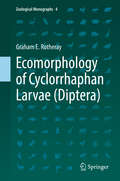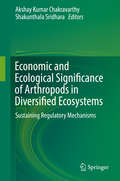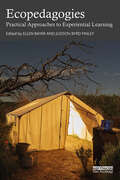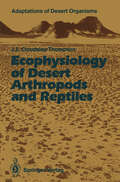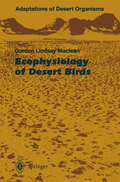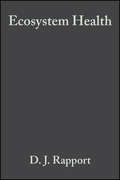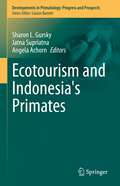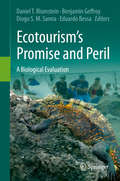- Table View
- List View
Ecology, Systematics, and the Natural History of Predaceous Diving Beetles (Coleoptera: Dytiscidae)
by Donald A. YeeThe 2nd edition of this comprehensive book provides one of the most complete overviews of the aquatic beetles in the family Dytiscidae, also known as predaceous diving beetles. Dytiscids constitute one of the largest families of freshwater insects with approximately 4,650 named species that come in a variety of sizes, colors, and habitat affinities. Although dytiscid adults and larvae are ubiquitous throughout a variety of aquatic habitats, and are important predators on other aquatic invertebrates and vertebrates, there are no compilations that have focused on summarizing the knowledge on aspects of their ecology, systematics, and biology. Chapters in this book summarize hitherto scattered topics, including their anatomy and habitats, chemical and community ecology, phylogenies and larval morphology including chaetotaxy, sexual systems, predation, dispersal, conservation, and cultural and historical aspects. The 2nd edition offers updates on the newest scientific findings on dytiscids and also includes a new chapter on the subterranean fauna from Australia. The information in this new edition is potentially beneficial to anyone working in aquatic systems where dytiscids are an important part of the food web. Moreover, readers will gain a greater appreciation of dytiscids as model organisms for investigations of fundamental principles derived from ecological and evolutionary theory. Contributed chapters are by authors who are actively engaged in studying dytiscids, and each chapter provides color photos and future directions for research.
Ecomorphology of Cyclorrhaphan Larvae (Zoological Monographs #4)
by Graham E. RotherayThis book offers an overview of the larva of Diptera Cyclorrhapha. It first discusses the principal forms, functions and roles of larvae, and then evaluates feeding, locomotion and respiration in larval saprophages, phytophages and zoophages as keys to understanding and predicting larval morphology. It also highlights how the environment affects morphology, the adaptiveness of morphological features and compares the adaptive features. Assessing the larval attributes that have the potential to explain the success of the Cyclorrhapha, the book also suggests future research directions and provides a summary of main findings and conclusions. As such, it appeals to entomologists, evolutionary biologists and Diptera researchers in all fields.
Ecomorphology of fishes (Developments in Environmental Biology of Fishes #16)
by Joseph J. Luczkovich Philip J. Motta Stephen F. Norton Karel F. LiemEcomorphology is the comparative study of the influence of morphology on ecological relationships and the evolutionary impact of ecological factors on morphology in different life intervals, populations, species, communities, and evolutionary lineages. The book reviews early attempts at qualitative descriptions of ecomorphological patterns in fishes, especially those of the Russian school. More recent, quantitative studies are emphasised, including multivariate approaches to ecomorphological analysis, the selection of functionally important ecological and morphological variables to analyze, an experimental approach using performance tests to examine specific hypotheses derived from functional morphology, and the evolutionary interpretations of ecomorphological patterns. Six major areas of fish biology are focused on: feeding, sensory systems, locomotion, respiration, reproduction, and phylogenetic relationships. The 18 papers in the volume document: (1) how the morphology of bony fishes constrains ecological patterns and the use of resources; (2) whether ecological constraints can narrow the niche beyond the limits imposed by morphology (fundamental vs. realized niche); (3) how communities of fishes are organized with respect to ecomorphological patterns; and (4) the degree to which evolutionary pressures have produced convergent or divergent morphologies in fishes. A concluding paper summarizes ecomorphological research in fishes and points out taxa that are underrepresented or are especially promising for future research.
Economic and Ecological Significance of Arthropods in Diversified Ecosystems: Sustaining Regulatory Mechanisms
by Akshay Kumar Chakravarthy Shakunthala SridharaArthropods are invertebrates that constitute over 90% of the animal kingdom, and their bio-ecology is closely linked with global functioning and survival.Arthropods play an important role in maintaining the health of ecosystems, provide livelihoods and nutrition to human communities, and are important indicators of environmental change. Yet the population trends of several arthropods species show them to be in decline. Arthropods constitute a dominant group with 1.2 million species influencing earth’s biodiversity. Among arthropods, insects are predominant, with ca. 1 million species and having evolved some 350 million years ago. Arthropods are closely associated with living and non-living entities alike, making the ecosystem services they provide crucially important. In order to be effective, plans for the conservation of arthropods and ecosystems should include a mixture of strategies like protecting key habitats and genomic studies to formulate relevant policies for in situ and ex situ conservation.This two-volume book focuses on capturing the essentials of arthropod inventories, biology, and conservation. Further, it seeks to identify the mechanisms by which arthropod populations can be sustained in terrestrial and aquatic ecosystems, and by means of which certain problematic species be managed without producing harmful environmental side-effects. This edited compilation includes chapters contributed by over 80 biologists on a wide range of topics embracing the diversity, distribution, utility and conservation of arthropods and select groups of insect taxa. More importantly, it describes in detail the mechanisms of sustaining arthropod ecosystems, services and populations. It addresses the contribution of modern biological tools such as molecular and genetic techniques regulating gene expression, as well as conventional, indigenous practices in arthropod conservation. The contributors reiterate the importance of documenting and understanding the biology of arthropods from a holistic perspective before addressing conservation issues at large. This book offers a valuable resource for all zoologists, entomologists, ecologists, conservation biologists, policy makers, teachers and students interested in the conservation of biological resources.
Economics for the Wilds: Wildlife, Wildlands, Diversity and Development (Routledge Library Editions: Ecology #13)
by Edward B. Barbier Timothy M. SwansonOriginally published in 1992 Economics for the Wilds argues that an economics that properly values the resources of the wilds offers the best long-term security for their future. Most of the world’s wilds have, in fact, always been utilized by local societies who have managed their resources sustainably, and one important guarantee for their preservation is therefore the continued participation of those communities and an adequate reward to them for their management. The book looks at the complexity and global nature of the issues, at the application of economics to the wilds and at the policies for their conservation and sustainable management which then result. It also examines specific forms of utilization of wild species and habitats, both sustainable and unsustainable, and including community-based development, tourism, the use of rainforest products, poaching and the impact of conservation on wildlife use. The book concludes that a comprehensive utilization strategy for wild resources is needed to ensure their continued existence and the continued flow of benefits from them.
Economics for the Wilds: Wildlife, Wildlands, Diversity and Development (Routledge Library Editions: Ecology #13)
by Timothy M. Swanson; Edward B. BarbierOriginally published in 1992 Economics for the Wilds argues that an economics that properly values the resources of the wilds offers the best long-term security for their future. Most of the world’s wilds have, in fact, always been utilized by local societies who have managed their resources sustainably, and one important guarantee for their preservation is therefore the continued participation of those communities and an adequate reward to them for their management. The book looks at the complexity and global nature of the issues, at the application of economics to the wilds and at the policies for their conservation and sustainable management which then result. It also examines specific forms of utilization of wild species and habitats, both sustainable and unsustainable, and including community-based development, tourism, the use of rainforest products, poaching and the impact of conservation on wildlife use. The book concludes that a comprehensive utilization strategy for wild resources is needed to ensure their continued existence and the continued flow of benefits from them.
The Economics of Farm Animal Welfare: Theory, Evidence and Policy
by Faical Akaichi Jean-Luc Angot Dr Santiago Avendaño Richard Bennett Bettina Bock Donald Broom Beth Clark David Harvey Carmen Hubbard Alfons Koerhuis Alistair Lawrence Carolina Maciel Anne-Marie Neeteson Jarkko K Niemi César Revoredo-Giha Alistair Stott Belinda VigorsThis landmark new text charts the latest developments in economic research relevant to farm animal welfare. A range of global experts and key opinion leaders outline the challenges in achieving sustainable livestock production while improving farm profit, climate change and animal welfare, and make policy-relevant recommendations for the future. This is a theoretical yet practical book that examines: - the origins of farm animal welfare, cross-disciplinary interactions and the future of the field; - consumer demand and changing preferences as animal welfare rises up the social agenda; - the impact political organisations such as the EU and WTO have on animal welfare. An important resource for policy makers and animal welfare scientists, economists and clinicians, this book provides a thought-provoking yet evidence-based review for all those interested in quantifying and improving farm animal welfare.
Ecopedagogies: Practical Approaches to Experiential Learning
by Ellen Bayer Judson Byrd FinleyEcopedagogies showcases a range of creative approaches that educators across multiple disciplines use to empower students to access and engage with nature, an increasingly important consideration in a post-COVID world in environmental crisis. The volume includes chapters written by scholars from the environmental arts and humanities, literature, writing studies, rhetoric, music, religious studies, environmental studies and sustainability, sociology and anthropology, physical education, and outdoor education. Each author walks the reader through the details of how their ecopedagogy works, identifies potential challenges while also detailing how to address them, and explains the rewards to students, instructors, and more-than-human nature that they have witnessed through the use of these approaches. The contributions represent diverse types of academic institutions, offering broad applicability to instructors, including community colleges, private liberal arts colleges, and large state, regional, public, and private universities. The book explores a series of key questions about how educators can facilitate meaningful learning experiences with the natural world, inside and outside the classroom, and it looks at how to foster inclusivity, navigate problems with access, and explore intersections with environmental justice. As a practical guide, the book delivers a well-provisioned toolbox containing exercises, activity guides, and assignments for those teaching environmentally focused college courses.
Ecopedagogies: Practical Approaches to Experiential Learning
by Ellen Bayer Judson Byrd FinleyEcopedagogies showcases a range of creative approaches that educators across multiple disciplines use to empower students to access and engage with nature, an increasingly important consideration in a post-COVID world in environmental crisis. The volume includes chapters written by scholars from the environmental arts and humanities, literature, writing studies, rhetoric, music, religious studies, environmental studies and sustainability, sociology and anthropology, physical education, and outdoor education. Each author walks the reader through the details of how their ecopedagogy works, identifies potential challenges while also detailing how to address them, and explains the rewards to students, instructors, and more-than-human nature that they have witnessed through the use of these approaches. The contributions represent diverse types of academic institutions, offering broad applicability to instructors, including community colleges, private liberal arts colleges, and large state, regional, public, and private universities. The book explores a series of key questions about how educators can facilitate meaningful learning experiences with the natural world, inside and outside the classroom, and it looks at how to foster inclusivity, navigate problems with access, and explore intersections with environmental justice. As a practical guide, the book delivers a well-provisioned toolbox containing exercises, activity guides, and assignments for those teaching environmentally focused college courses.
Ecophenomenology and the Environmental Crisis in the Sundarbans: Towards a Community-Based Ethic (Routledge Explorations in Environmental Studies)
by Kalpita Bhar PaulThis book offers a philosophical analysis of the environmental crisis in the Indian Sundarbans, drawing upon phenomenological narratives. It nuances the present understanding of the crisis by introducing plurality in our metaphysical understanding of the environment and epistemological understanding of the human–environment relationship.Contemporary research on the Sundarbans mainly focuses on the impending threat of climate change, natural disasters, as well as increasing human–animal conflict, conservation, and forest access debates, while scholarly works have mostly used environmental impact assessments to offer technocratic solutions that prioritize a particular type of human–environment relationship characterized by an "anticipation of ruin." Rather than rushing to find solutions, I embark on a journey to unpack the meaning of crisis through phenomenological narratives of human–environment relationships. A deep dive into the human–environment relationship through an intentional engagement with the work-worlds of islanders, the formation of a more-than-human community is revealed, giving rise to community-based ethic that transcends the poverty of thought and imagination in comprehending the crisis of the Indian Sundarbans. This new ethical framework emphasizes the co-emergence of self-consciousness and eco-consciousness, serving as a moral impetus for individuals to act ethically towards the environment. This approach impels us to rethink what the Sundarbans is, how the crisis gets manifested to the inlanders and outsiders, and what kind of procedural changes are required to protect the Sundarbans as a living ecosystem instead of a natural museum.The book’s phenomenological depth and engaged philosophical framework will elicit deep interest from within academia and among practitioners who are working in environmental studies, philosophy, human ecology, and island studies. The convergence of conceptual understandings and field narratives will also draw the interest of research students working in correlated fields.
Ecophenomenology and the Environmental Crisis in the Sundarbans: Towards a Community-Based Ethic (Routledge Explorations in Environmental Studies)
by Kalpita Bhar PaulThis book offers a philosophical analysis of the environmental crisis in the Indian Sundarbans, drawing upon phenomenological narratives. It nuances the present understanding of the crisis by introducing plurality in our metaphysical understanding of the environment and epistemological understanding of the human–environment relationship.Contemporary research on the Sundarbans mainly focuses on the impending threat of climate change, natural disasters, as well as increasing human–animal conflict, conservation, and forest access debates, while scholarly works have mostly used environmental impact assessments to offer technocratic solutions that prioritize a particular type of human–environment relationship characterized by an "anticipation of ruin." Rather than rushing to find solutions, I embark on a journey to unpack the meaning of crisis through phenomenological narratives of human–environment relationships. A deep dive into the human–environment relationship through an intentional engagement with the work-worlds of islanders, the formation of a more-than-human community is revealed, giving rise to community-based ethic that transcends the poverty of thought and imagination in comprehending the crisis of the Indian Sundarbans. This new ethical framework emphasizes the co-emergence of self-consciousness and eco-consciousness, serving as a moral impetus for individuals to act ethically towards the environment. This approach impels us to rethink what the Sundarbans is, how the crisis gets manifested to the inlanders and outsiders, and what kind of procedural changes are required to protect the Sundarbans as a living ecosystem instead of a natural museum.The book’s phenomenological depth and engaged philosophical framework will elicit deep interest from within academia and among practitioners who are working in environmental studies, philosophy, human ecology, and island studies. The convergence of conceptual understandings and field narratives will also draw the interest of research students working in correlated fields.
Ecophysiology of Amphibians Inhabiting Xeric Environments (Adaptations of Desert Organisms)
by Michael WarburgA description of the structural and functional adaptations of the key organs such as skin, kidneys, bladder, lungs and ovaries, with special emphasis placed on physiological adaptations: water, electrolyte, nitrogen, and thermal balance and their endocrine control. One whole chapter devoted to ecological aspects covers such exciting topics as development and metamorphosis, larval competition for food resources, and reproductive strategies.
Ecophysiology of Desert Arthropods and Reptiles (Adaptations of Desert Organisms)
by John L. Cloudsley-ThompsonEcophysiology of Desert Arthropods and Reptiles starts with a new classification of the world's deserts, based upon the type of precipitation and the effect on their faunas of arthropods and reptiles. This is followed by an account of microclimates and the avoidance of environmental extremes. Whereas thermoregulation is primarily behavioural, responses to water shortage are largely physiological. Seasonal activity and phenology are described, adaptations for burrowing, the avoidance of enemies, and defence, are also outlined. A comparative account of interspecific relationships, feeding specializations, and species diversity in the two taxa is described. The purpose of the book is to provide a new and up-to-date analysis that will stimulate further research along these lines.
Ecophysiology of Desert Birds (Adaptations of Desert Organisms)
by Gordon L. MacleanIn the Preface to his volume on Ecophysiology of the Camelidae and Desert Ruminants in this series, Trevor Wilson mentions his hesitation at the invitation from John Cloudsley-Thompson to write the book, because he had been out of direct touch with desert biology for some years. My response to John's invitation to write Ecophysiology of Desert Birds was much the same, and for the same reasons. However, with his encouragement and, taking account of the fact that a colleague of mine who is much better suited to do the job had turned it down because of pressure of work, I accepted the challenge and have enjoyed it immensely. It has been my privilege to spend much time in the deserts of North and South America, southern Africa and Australia, some of it with my wife, Cherie, whose editing of the entire text has improved the work immeasurably. Indeed, I believe it would have been proper for her to accept coauthorship, but she graciously declined the offer! I owe her a debt of gratitude which I hope will be repaid in part by her seeing the text finally between covers. The chapters on water regulation (Chap. 5) and thermo regulation (Chap. 6) have benefited from the refereeing of my colleague, Dr. Barry Lovegrove, of the Department of Zoology and Entomology, University of Natal, Pietermaritzburg.
Ecophysiology of Small Desert Mammals (Adaptations of Desert Organisms)
by Allan A. DegenSince small mammals have a large surface to mass ratio, one would expect them to quickly dehydrate and perish at high environmental temperatures. Nonetheless, a large number of small mammal species inhabit deserts. This fascinating phenomenon is investigated by Prof. A. Allan Degen in his book.The majority of small desert mammals are rodents, but shrews of several grams and small foxes of 1 kg are also present. Their survival is due mainly to behavioural adaptations and habitat selection, however, physiological adaptations also contribute to the success. Interestingly, many small mammals that live in different deserts of the world show similarities in their adaptive traits although they have different taxonomic affinities.
Ecophysiology of Spiders
by Wolfgang NentwigRecently another book on insect physiology was published. It was restricted to a few focal points as are many of these new insect physiology books, but there was considerable depth in its specialized point of view. We were dis cussing the structure of this book and of insect physiology books, in general, when Prof. Remmert asked me " . . . and what about books on spider physio logy?" Silence. Then I started to explain "oh yes, there is a congress pro ceedings volume on this topic and there is a group with excellent publica tions on another topic . . . ", but I felt that this answer was weak. One can no longer buy the proceedings volume in a bookshop and to read a series of publications on a given topic one must search in a library for a dozen journals. Why is there not a single book on spider physiology comparable with the many books on insect physiology? Are spiders a scientific ivory tower, far from public interest and commercial importance? I do not think so, although spiders are one of the many "forgotten" animal groups which always grew in the shadow of the insects. There are research groups working on spider physiology, there are fascinating phenomena in this animal group and there are plenty of exciting results. Spiders may have been always underresearch ed, but research is progressing. In the last few years, new books have been published, e. g.
Ecophysiology of the Camelidae and Desert Ruminants (Adaptations of Desert Organisms)
by Richard T. WilsonI have spent less time in the arid zone in the last few years than I did during the 1960's, 1970's and early 1980's. This results from a progression through age and a career structure which gradually shifted the emphasis of my work from being essentially field-oriented to essentially office-hound. When, therefore, I was asked by John Cloudsley-Thompson to undertake the writing of this hook I hesitated for two reasons. One reason was that, although I now had access to good library facilities and kept up with the literature on the arid zones and their fauna, I was not sure that a sedentary and pleasant life in a temperate highland island in tropieal Africa would provide a mental attitude suitable to writing a hook which related to areas where life is usually nomadie and often extremely disagreeable. The other reason was that I was uncertain whether I could devote the time necessary to researehing and writing the hook on top of my professional (which now specifical ly excluded research in the arid zones and on camels) and social (new-found and time-consuming) commitments. In the event I accepted and the fates were kind to me. By some peculiar combination of circumstances I was given the opportunity to spend a considerable part of the first half of 1988 in some of the driest areas of the globe. I had already visited all of the locations used for the construction of Fig. 2.
Ecosystem-Based Fisheries Management: Progress, Importance, and Impacts in the United States
by Jason S. Link Anthony R. MarshakEcosystem-based fishery management (EBFM) is rapidly becoming the default approach in global fisheries management. The clarity of what EBFM means is sharpening each year and there is now a real need to evaluate progress and assess the effectiveness and impacts. By examining a suite of over 90 indicators (including socioeconomic, governance, environmental forcing, major pressures, systems ecology, and fisheries criteria) for 9 major US fishery ecosystem jurisdictions, the authors systematically track the progress the country has made towards advancing EBFM and making it an operational reality. The assessment covers a wide range of data in both time (multiple decades) and space (from the tropics to the poles, representing over 10% of the world's ocean surface area). The authors view progress towards the implementation of EBFM as synonymous with improved management of living marine resources in general, and highlight the findings from a national perspective. Although US-centric, the lessons learned are directly applicable for all parts of the global ocean. Much work remains, but significant progress has already been made to better address many of the challenges facing the sustainable management of our living marine resources. This is an essential and accessible reference for all fisheries professionals who are currently practicing, or progressing towards, ecosystem-based fisheries management. It will also be of relevance and use to researchers, teachers, managers, and graduate students in marine ecology, fisheries biology, biological oceanography, global change biology, conservation biology, and marine resource management.
Ecosystem Health: Principles and Practice
by D. J. Rapport Connie L. Gaudet R. Constanza P. R. Epstein R. LevinsEcosystem Health presents information to help the environmental sciences community further understand the relationships between ecosystem health and human health. By exploring preventative, diagnostic and prognostic aspects of ecosystem management and using case-study examples, the book takes the reader from theory to practice in this emerging integrative science.
Ecosystem Services in Agricultural and Urban Landscapes
by Stephen Wratten Harpinder Sandhu Ross Cullen Robert CostanzaEcosystem services are the resources and processes supplied by natural ecosystems which benefit humankind (for example, pollination of crops by insects, or water filtration by wetlands). They underpin life on earth, provide major inputs to many economic sectors and support our lifestyles. Agricultural and urban areas are by far the largest users of ecosystems and their services and (for the first time) this book explores the role that ecosystem services play in these managed environments. The book also explores methods of evaluating ecosystem services, and discusses how these services can be maintained and enhanced in our farmlands and cities. This book will be useful to students and researchers from a variety of fields, including applied ecology, environmental economics, agriculture and forestry, and also to local and regional planners and policy makers.
Ecosystem Services in Agricultural and Urban Landscapes
by Steve WrattenEcosystem services are the resources and processes supplied by natural ecosystems which benefit humankind (for example, pollination of crops by insects, or water filtration by wetlands). They underpin life on earth, provide major inputs to many economic sectors and support our lifestyles. Agricultural and urban areas are by far the largest users of ecosystems and their services and (for the first time) this book explores the role that ecosystem services play in these managed environments. The book also explores methods of evaluating ecosystem services, and discusses how these services can be maintained and enhanced in our farmlands and cities. This book will be useful to students and researchers from a variety of fields, including applied ecology, environmental economics, agriculture and forestry, and also to local and regional planners and policy makers.
Ecosystems and Living Resources of the Baltic Sea: Their assessment and management
by Evald OjaveerThis volume presents a reconstruction of the formation of the environmental conditions and biota in the present-day Baltic Sea area during the last glacial cycle and thereafter under the influence of extra-terrestrial, climatic and geological factors. Abiotic conditions in the contemporary Baltic Sea (water salinity, temperature, oxygen and light conditions, currents and other water movements) are characterized and in this background the natural regional system of the sea has been generated. Important issues are considered such as life forms in the Baltic and their dependence on the natural environment (both in the conditions of the relative stable environment and during the regime shifts), as well as anthropogenic influences and the basic differences between the areas of the World Ocean and the brackish Baltic Sea. This book also equips readers with basic principles of assessments and management of ecosystems and fish resources (including the long-term assessment and forecast on ecosystems and fish resources) and provides information on the structures of international collaboration developed in the Baltic Sea.
Ecotourism and Indonesia's Primates (Developments in Primatology: Progress and Prospects)
by Sharon L. Gursky Jatna Supriatna Angela AchornThe basic goal of the volume is to compile the most up to date research on the effect of ecotourism on Indonesia’s primates. The tremendous diversity of primates in Indonesia, in conjunction with the conservation issues facing the primates of this region, have created a crisis whereby many of Indonesia’s primates are threatened with extinction. Conservationists have developed the concept of “sustainable ecotourism” to fund conservation activities. National parks agencies worldwide receive as much as 84% of their funding from ecotourism. While ecotourism funds the majority of conservation activities, there have been very few studies that explore the effects of ecotourism on the habitat and species that they are designed to protect. It is the burgeoning use of “ecotourism” throughout Indonesia that has created a need for this volume where the successes and pitfalls at various sites can be identified and compared.
Ecotourism’s Promise and Peril: A Biological Evaluation
by Daniel T. Blumstein Benjamin Geffroy Diogo S. Samia Eduardo BessaIntended as a guide for wildlife managers and ecotourism operators, as well as interested ecotourists, this book addresses the biological principles governing how ecotourism affects wildlife. The introductory chapters focus on four key responses to human visitation—behavioral, physiological, ecological, and evolutionary. Readers will discover ecotourism’s effects on biodiversity in connection with various industries that are habitat or taxonomically specific: fish tourism (including both freshwater and marine), marine mammal tourism, the huge industry centered on terrestrial animals, and the well-studied industry of penguin tourism. Given that the costs and benefits of ecotourism cannot be meaningfully assessed without understanding the human context, particular attention is given to how ecotourism has been used as part of community development. In closing, the book synthesizes the current state of knowledge regarding best practices for reducing human impacts on wildlife. The final chapter highlights key research questions that must be addressed to provide more evidence-based guidelines and policy.
Ecotoxicology: Pesticides and beneficial organisms
by Peter T. Haskell Peter McEwenFollowing the original initiative of the International Organisation for Biological Control some 15 years ago, research groups and agrochemical companies have been investigating the effects of pesticides on beneficial organisms, devising laboratory and field test methods and lately developing protocols for regulatory testing requirements in Europe. This work, and the application of agreed protocols for testing, is of crucial importance to the environmentally acceptable use of pesticides and to the further development of Integrated Pest Management systems, and the objective of this book is to review the origins and progress of the research - what has been accomplished, what is the current position and what still needs to be done.

